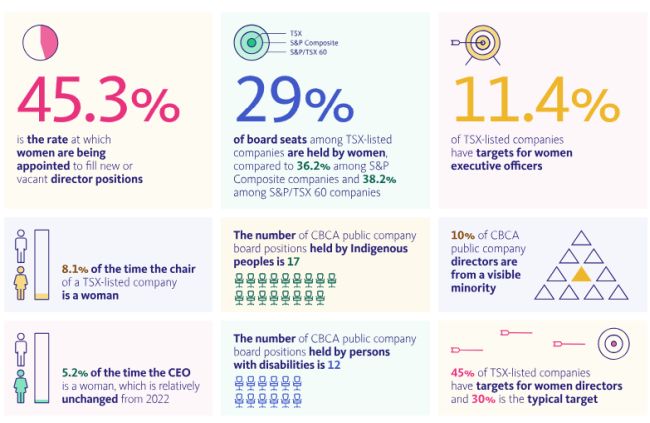Introduction
Canada's board diversity journey has been a study in ongoing change. After nine years of disclosure, it would not be a surprise if progress in increasing the representation of women on boards began to show signs of slowing. Yet we continue to see the proportion of women on boards increase year over year at a rate comparable to prior years. A similar trend is beginning to emerge with respect to the representation of directors from visible minorities, although there has been little to no progress among Indigenous peoples and persons with a disability at the board level.
Among executive officers, the proportion of women has increased significantly annually among Canada's largest companies for the last few years, but this pattern has been primarily driven by the S&P/TSX Composite Index companies and not yet been emulated by smaller companies. And virtually no progress has been made among Indigenous peoples and persons with a disability at the executive officer level.
This, our ninth annual report, once again provides detailed disclosure on the representation of women in senior leadership positions at TSX-listed companies as well as the representation of women, members of visible minorities, Indigenous peoples and persons with disabilities at publicly-traded corporations governed by the Canada Business Corporations Act (CBCA). We also highlight disclosed best practices to improve diversity and inclusion as well as samples of excellence in disclosure.
Women are being added to boards at their fastest rate ever
To achieve parity, new or vacant positions need to be filled by women candidates at least half the time. Canadian companies are getting close – and the rate at which women were added to boards this year is higher than reported in any of our prior reports. Among the 532 board positions which were newly created or vacated, a woman was chosen to fill the position 45.3% of the time. This result reflects a push by companies which had only one woman director to add more women, significantly reducing the number of one-woman boards.
Almost 30%
Women hold almost 30% of all board seats among TSX-listed companies. The jump in the rate at which women are being appointed to boards boosted the percentage of board seats held by women to 29% compared to 26% last year. Larger companies continue to demonstrate better diversity, with women holding 36.2% of all board seats among the S&P/TSX Composite Index companies and 38.2% of all board seats among the S&P/TSX 60 companies. In light of this result, it comes as no surprise that among the 278 companies that have adopted targets for women directors, two-thirds (66.9%) have adopted a target of 30%.
Yet there was little change in the percentage of TSX-listed companies with all-male boards. The percentage declined only slightly to 10.6% (67 companies) compared to 11.6% in 2022. These holdouts are smaller companies since, like last year, there were no single gender boards among the S&P/TSX Composite Index companies. Absent a legal requirement to enhance their board diversity, it is unclear what would motivate any of these 67 companies, one-third of which are mining companies, to make a change.
One out of every 10 directors is from a visible minority
CBCA corporations continue to add directors who are from a visible minority at an increasing rate. This year, visible minority directors hold 10.2% of board seats among all CBCA corporations providing disclosure, compared to 8.3% in 2022 and 6.8% in 2021. This progress reflects a growing demand by investors for visible minority representation on boards, and is consistent with initiatives to increase ethnic diversity on the boards of U.K. companies and the representation of underrepresented groups under NASDAQ listing requirements.
The proportion of Indigenous directors and directors who are persons with a disability, however, was essentially unchanged compared to last year.
The proportion of women executive officers is growing, but not for diversity beyond gender
Women are making increasing inroads into the C-suite, although at a slow rate. On average, 21% of executive officers are women, compared to 20% in 2022 and 18% in 2021. Among S&P/TSX 60 companies, one out of every four executive officers (27%) is a woman.
The average number of executive officers who are members of visible minorities increased significantly from mid-year 2022 and there is now on average 0.88 visible minority executive officers per CBCA company. However, the average number of executive officers who are Indigenous peoples or persons with a disability was virtually unchanged year over year.
More to come
Although the proportion of women on Canadian boards continues to increase, and gender diversity on boards in Canada is on a par with levels on U.S. and Australian boards, progress lags that made in other jurisdictions. Even among Canada's largest companies, gender diversity has not reached the 40% level reached by the 350 largest companies in the United Kingdom, nor the levels achieved in jurisdictions which have adopted quotas. We expect continued increases in the proportion of women directors. We also expect the proportion of executive officers to continue to rise, although at a slower rate. Current interest in increasing visible minority representation on public company boards should result in increased representation, potentially at an increased rate if the Canadian Securities Administrators (CSA) mandate disclosure of visible minority representation. The journey is not over and we hope this report will help inspire continued progress.
Highlights

The Diversity Disclosure Requirement
The Diversity Disclosure Requirement requires disclosure:
- Whether or not the issuer has adopted a written policy relating
to the identification and nomination of women directors. If the
issuer has not adopted such a policy, it must disclose why it has
not done so. If an issuer has adopted a policy, the issuer must
disclose:
- a short summary of its objectives and key provisions
- the measures taken to ensure that the policy has been effectively implemented
- annual and cumulative progress by the issuer in achieving the objectives of the policy
- whether, and if so how, the board or its nominating committee measures the effectiveness of the policy
- Whether the issuer considers the level of representation of women on the board in identifying and nominating candidates for election or re-election to the board. If so, the issuer must disclose how and, if not, disclose the issuer's reason for not doing so.
- Whether the issuer considers the level of representation of women in executive officer positions when making such appointments. If so, the issuer must disclose how and, if not, disclose the issuer's reason for not doing so.
- Whether the issuer has adopted a target regarding the appointment of women to the board. If so, the issuer must disclose the target and the annual and cumulative progress of the issuer in achieving the target. If not, the issuer must disclose the reason for not doing so.
- Whether the issuer has adopted a target regarding women in executive officer positions of the issuer. If so, the issuer must disclose the target and the annual and cumulative progress of the issuer in achieving the target. If the issuer has not adopted a target, it must disclose why it has not done so.
- The number and percentage of women on the issuer's board of directors.
- The number and percentage of the issuer's women executive officers, including all major subsidiaries of the issuer.
To view the full article click here
The content of this article is intended to provide a general guide to the subject matter. Specialist advice should be sought about your specific circumstances.





